Last year you tried a French Bûche de Noël at a friend’s holiday potluck and it changed how you think about Christmas desserts. Now you’ll learn 12 global recipes—from Mexican tamales to Filipino bibingka—that cover mains, sides, sweets, and drinks with clear, practical steps and simple ingredient lists. Pick a region, gather basics, and follow the recipes to bring new flavors to your table; keep going to find one that fits your skill level and pantry.
Bûche De Noël (French Yule Log)
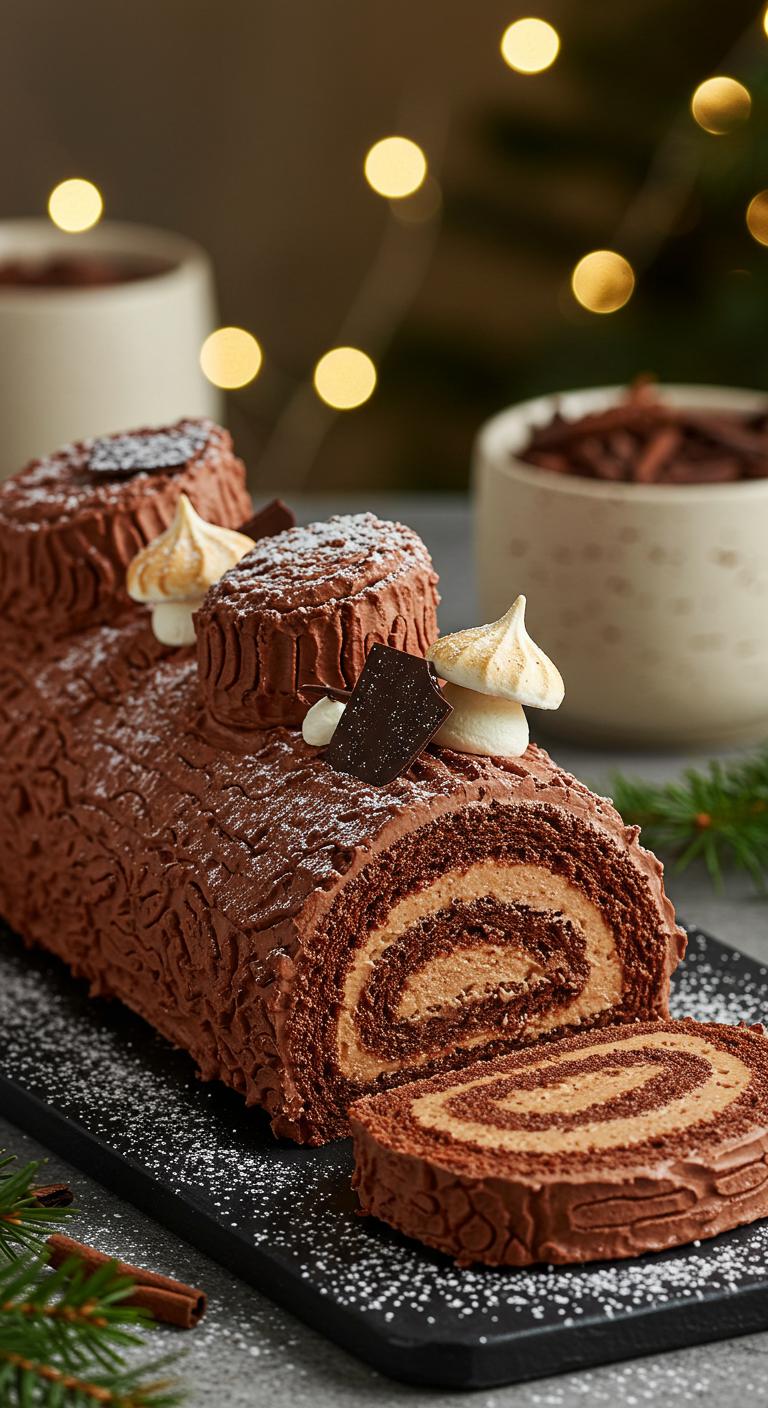
A classic French holiday centerpiece — a chocolate sponge cake rolled and dressed to look like a festive Yule log.
Ingredients:
- 4 large eggs, separated
- 100 g (1/2 cup) granulated sugar
- 30 g (1/4 cup) powdered sugar, for dusting and sweetness
- 75 g (2/3 cup) all-purpose flour, sifted
- 25 g (1/4 cup) cocoa powder, sifted
- 1/4 tsp salt
- 1 tsp vanilla extract
- 2 tbsp milk
- 200 ml (3/4 cup + 1 tbsp) heavy cream, chilled
- 150 g (5 oz) dark chocolate, finely chopped
- 2 tbsp unsalted butter, room temperature
- Optional: powdered sugar for “snow,” chocolate shavings or meringue mushrooms for decoration
How to Make:
- Preheat the oven to 200°C (400°F). Line a 10×15-inch (25×38 cm) jelly roll pan with parchment and lightly grease it.
- Whisk the egg yolks with half the granulated sugar until pale and slightly thick; stir in vanilla and milk.
- In a separate bowl, sift together flour, cocoa powder, and salt.
- Fold the dry ingredients into the yolk mixture gently until combined.
- Beat the egg whites until soft peaks form, then gradually add the remaining sugar and whip to stiff glossy peaks.
- Gently fold one-third of the whites into the batter to loosen it, then fold in the rest carefully to keep the batter airy.
- Spread the batter evenly in the prepared pan and bake 10–12 minutes, until the cake springs back when touched.
- While warm, dust a clean kitchen towel with powdered sugar, turn the cake onto the towel, peel off the parchment, and roll the cake (towel inside) from the short end. Cool completely rolled up.
- For the filling, heat 100 ml of the cream until just simmering, pour over the chopped dark chocolate, let sit a minute, then stir until smooth. Stir in butter and cool until spreadable.
- Whip the remaining 100 ml cream to soft peaks and fold into the cooled chocolate mixture to make a lighter chocolate mousse-like filling.
- Unroll the cooled cake, spread the filling evenly, and re-roll tightly without the towel. Trim one end at an angle and attach it to the side to form a branch.
- To make the frosting, melt remaining chocolate with a little cream until smooth, or whip additional whipped cream chocolate ganache to a spreadable consistency, then cover the roll. Use a fork to texture bark lines.
- Chill the log for at least 1 hour to set. Dust with powdered sugar and decorate with chocolate shavings or meringue mushrooms if desired.
Enjoy your Bûche de Noël — a slice of festive chocolatey tradition!
Tamales De Navidad (Mexican Christmas Tamales)
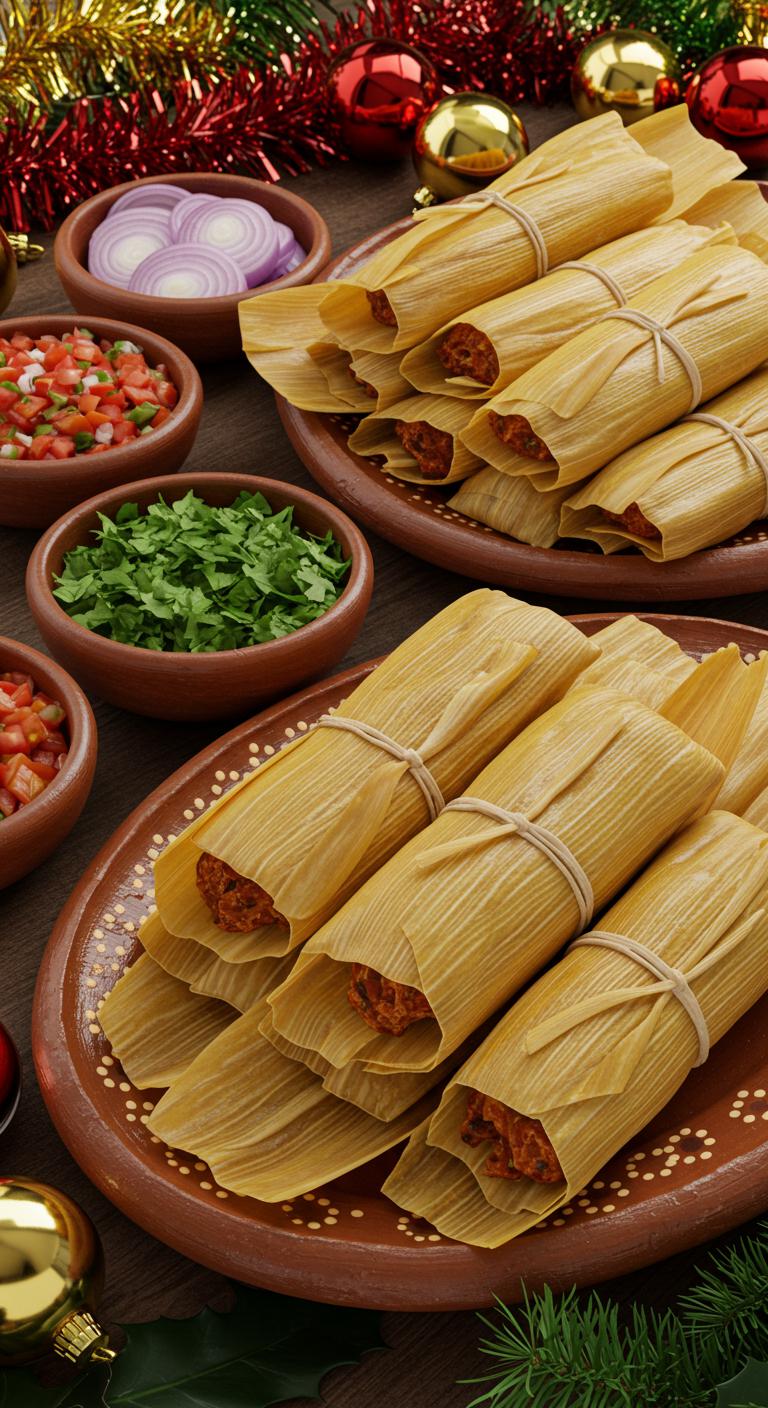
A festive, savory bundle of masa and saucy pork wrapped in corn husks — perfect for sharing at Christmas.
Ingredients:
- 3 lbs pork shoulder, cut into large chunks
- 4 dried guajillo chiles
- 3 dried ancho chiles
- 2 garlic cloves
- 1 medium white onion (half for sauce, half sliced for serving)
- 2 tsp dried oregano
- 1 tsp ground cumin
- 2 bay leaves
- Salt and black pepper to taste
- 3 cups chicken broth (plus extra if needed)
- 4 cups masa harina for tamales
- 1 1/2 tsp baking powder
- 1 tsp salt (for masa)
- 1 cup lard or vegetable shortening, softened
- 2 tbsp vegetable oil
- About 40–50 dried corn husks, soaked in warm water until pliable
- Fresh cilantro for garnish (optional)
- Salsa or extra sauce for serving (optional)
How to Make:
- Rinse and stem the dried chiles, removing seeds; soak them in hot water for 20 minutes until softened.
- In a blender, combine soaked chiles, half the onion, garlic, oregano, cumin, and 1 cup chicken broth; blend until smooth.
- Season pork chunks with salt and pepper. In a large pot, heat oil over medium-high heat and brown the pork on all sides.
- Pour the blended chile sauce over the pork, add bay leaves and remaining chicken broth to mostly cover the meat. Bring to a simmer.
- Reduce heat, cover, and cook 1.5–2 hours until pork is very tender and shreds easily. Remove bay leaves.
- Shred pork with two forks and return to pot; simmer a few minutes to thicken sauce. Adjust salt.
- While pork cooks, prepare masa: in a large bowl, mix masa harina, baking powder, and 1 tsp salt.
- Beat lard (or shortening) until fluffy, then add to masa mixture and slowly add about 1–1.5 cups chicken broth until dough is soft and spreadable — it should be light and slightly sticky.
- Drain corn husks and pat dry. Tear a few husks into thin strips to use as ties.
- To assemble, spread about 2–3 Tbsp masa on the center of a husk, leaving a border; add 1–2 Tbsp shredded pork with sauce on top of the masa.
- Fold the sides of the husk toward the center, then fold up the bottom; tie with a husk strip if desired. Repeat until all masa and filling are used.
- Arrange tamales standing upright in a large steamer pot with a rack, with open ends up. Add boiling water below the rack (not touching tamales), cover with a damp cloth and lid.
- Steam tamales for 1.5–2 hours, checking water occasionally and adding more as needed. Test one tamal — masa should pull away from the husk easily when done.
- Let tamales rest 10 minutes before serving. Serve hot with sliced onion, cilantro, and extra sauce or salsa.
Enjoy the warm, comforting tradition — unwrap a tamal and savor a little Christmas magic!
Panettone (Italian Christmas Bread)
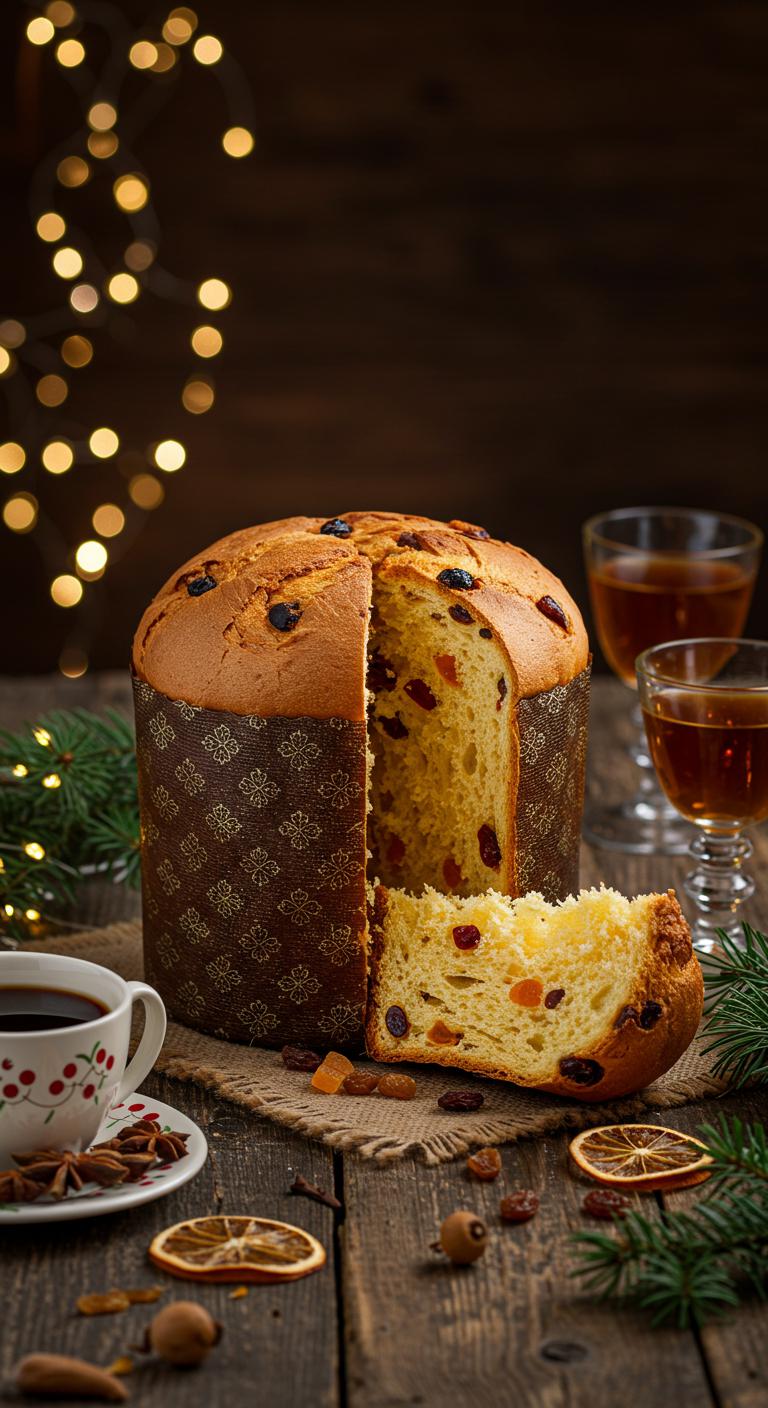
Panettone — light, airy Italian Christmas bread studded with sweet fruit and citrus zest.
Ingredients:
- 4 cups (500 g) all-purpose flour
- 1/2 cup (100 g) granulated sugar
- 2 1/4 tsp (1 packet) active dry yeast
- 1/2 tsp salt
- 4 large eggs, room temperature
- 1/2 cup (120 ml) whole milk, warmed to about 100–110°F (38–43°C)
- 1/2 cup (115 g) unsalted butter, softened
- 1 tsp vanilla extract
- Zest of 1 orange and 1 lemon
- 1 cup (150 g) mixed dried fruit (raisins, candied orange peel, etc.)
- 1/4 cup (30 g) chopped almonds or pine nuts (optional)
- 1–2 tbsp rum or warm water (to soak the fruit, optional)
- Extra flour or oil for handling and greasing the pan
How to Make:
- If using, soak the dried fruit in rum or warm water for 15–30 minutes, then drain and pat dry.
- Warm the milk slightly and dissolve the yeast in it; let sit 5–10 minutes until foamy.
- In a large bowl, whisk together the flour, sugar, salt, and citrus zest.
- Add the eggs, vanilla, and the yeast-milk mixture to the dry ingredients and mix until combined.
- Add the softened butter a little at a time, kneading until the dough is smooth, elastic, and slightly sticky (about 10–15 minutes by hand or 6–8 minutes with a stand mixer).
- Fold in the drained dried fruit and nuts until evenly distributed.
- Place the dough in a lightly greased bowl, cover, and let rise in a warm spot until doubled in size, about 1.5–2 hours.
- Punch the dough down gently and shape it into a ball that will fit into a panettone mold or a tall, greased round pan lined with parchment.
- Place the shaped dough in the pan, cover, and let rise again until it reaches near the top of the mold, about 1–1.5 hours.
- Preheat the oven to 350°F (175°C). If desired, brush the top lightly with beaten egg for a glossy finish.
- Bake for 30–40 minutes, covering the top with foil if it browns too quickly; bake until a skewer comes out clean and the internal temperature is about 190–200°F (88–93°C).
- Remove from the oven, cool slightly, then invert the panettone onto a rack; if you want the classic airy structure, some bakers suspend the loaf upside down to cool completely.
- Let cool fully before slicing and serving.
Enjoy warm slices of this festive, citrusy bread — perfect with coffee or a glass of dessert wine!
Bibingka and Puto Bumbong (Philippine Christmas Rice Cakes)
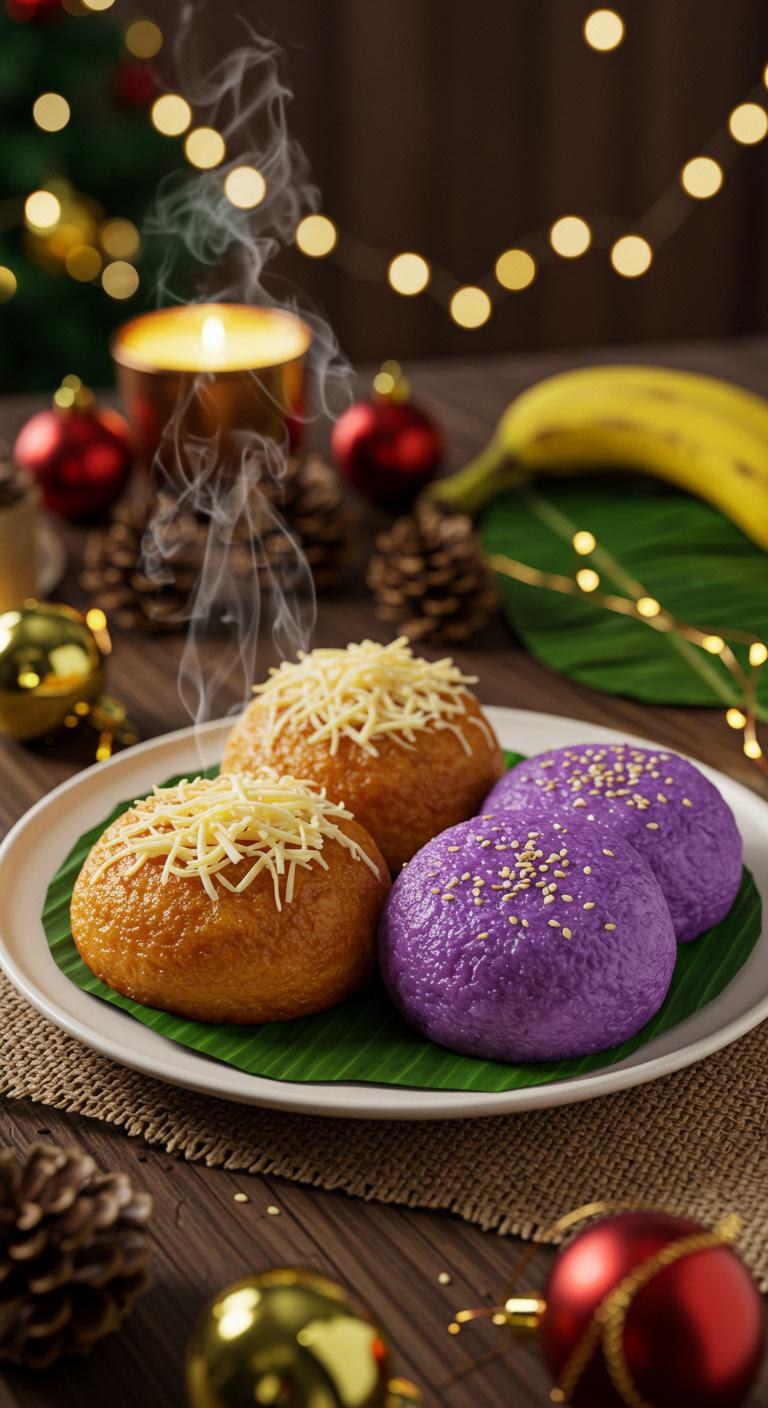
Bibingka and Puto Bumbong — soft, sweet, and smoky Filipino Christmas rice cakes that smell like holiday nostalgia.
Ingredients:
- 2 cups glutinous rice flour (for puto bumbong)
- 1 cup rice flour (for bibingka)
- 1 cup coconut milk
- 1 cup water
- 1 cup sugar (split: 1/2 cup for batter, 1/2 cup for topping or to taste)
- 2 tsp baking powder
- 1/2 tsp salt
- 2 large eggs (for bibingka)
- 1/4 cup melted butter or coconut oil (plus extra for greasing and brushing)
- 1/2 cup grated mature coconut (for topping)
- 1/2 cup grated cheddar or kesong puti (for bibingka topping; optional)
- Banana leaves or parchment paper (for lining molds)
- Purple food coloring or ube extract (optional, for puto bumbong color)
- Toasted sesame seeds or latik (coconut caramel) for garnish (optional)
How to Make:
- Prepare banana leaves by quickly passing them over low flame to soften, then cut to fit molds; if unavailable use parchment.
- For bibingka batter: whisk rice flour, 1/2 cup sugar, baking powder, and salt in a bowl.
- In another bowl, combine coconut milk, melted butter, and eggs; whisk until smooth.
- Pour wet mix into dry ingredients and stir until a smooth batter forms; set aside to rest 10 minutes.
- Preheat oven to 375°F (190°C) and grease small round cake pans or a large baking dish; line with banana leaves or parchment.
- Pour bibingka batter into prepared pans about 3/4 full; sprinkle grated cheese and a bit of extra butter on top if using.
- Bake bibingka 18–25 minutes, until top is slightly golden and a toothpick comes out clean.
- While bibingka bakes, make puto bumbong dough: mix glutinous rice flour with water, coconut milk, and a pinch of salt; add purple coloring or ube if desired.
- Knead until a pliable, slightly sticky dough forms; break into small portions and roll into long tube shapes about 3–4 inches long and 1/2 inch thick.
- Steam puto bumbong tubes in a bamboo steamer or regular steamer for 10–12 minutes until tender and glossy.
- Remove bibingka from oven, brush with melted butter, sprinkle with sugar, grated coconut, and cheese if using.
- Plate puto bumbong, brush with butter, sprinkle with grated coconut and a little sugar, and finish with toasted sesame seeds or latik if desired.
- Serve both warm — bibingka sliced and puto bumbong alongside — and enjoy the classic Filipino Christmas flavors.
Enjoy every bite of these cozy, festive rice cakes — perfect for sharing with family and friends!
Roast Goose With Red Cabbage (Central/Eastern European Holiday Roast)
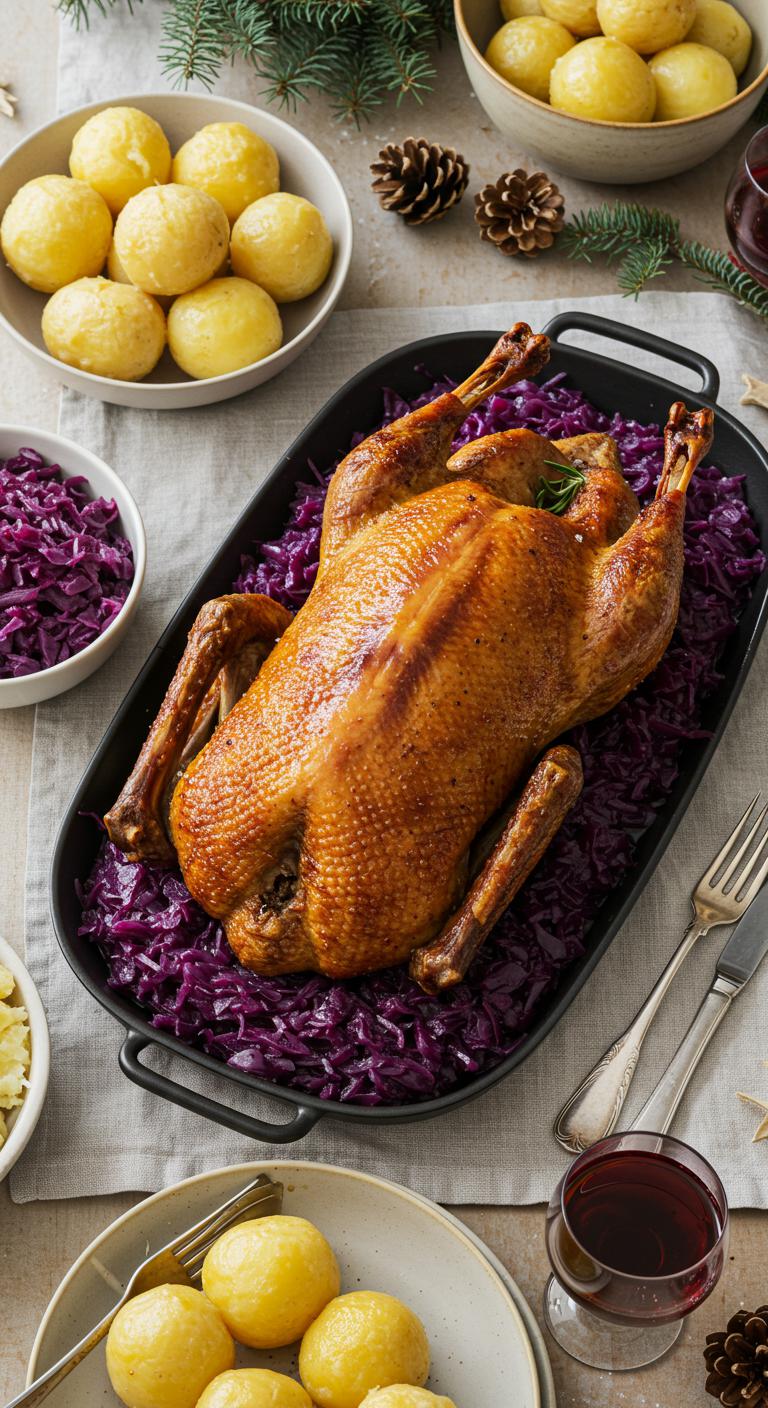
A holiday showstopper: crispy roast goose with tangy-sweet braised red cabbage — a Central/Eastern European classic.
Ingredients:
- 1 whole goose (10–12 pounds), giblets removed and neck reserved if desired
- 1 1/2 teaspoons kosher salt plus more to taste
- 1 teaspoon black pepper
- 2 teaspoons caraway seeds (optional)
- 2 apples, cored and quartered (preferably tart apples like Bramley or Granny Smith)
- 2 onions, peeled and quartered
- 4 garlic cloves, smashed
- 1 cup dry white wine or apple cider
- 1 bay leaf
- 1 tablespoon honey or brown sugar (for glaze)
- 2 tablespoons balsamic vinegar (for glaze)
- 2 tablespoons butter, melted (for finishing)
For the braised red cabbage:
- 1 medium head red cabbage (about 2–3 pounds), cored and thinly sliced
- 1 large onion, thinly sliced
- 2 tablespoons butter or goose fat
- 1 apple, peeled, cored and grated
- 1/3 cup brown sugar (adjust to taste)
- 1/3 cup apple cider vinegar or red wine vinegar
- 1/2 cup apple cider or water
- 1 teaspoon ground cinnamon
- 1/2 teaspoon ground allspice (or 3–4 whole allspice berries)
- Salt and black pepper to taste
How to Make:
- Preheat oven to 325°F (165°C).
- Pat the goose dry inside and out with paper towels.
- Prick the skin all over with a fork or skewer, taking care not to pierce the meat; this helps fat render.
- Season the cavity with 1 teaspoon salt, 1/2 teaspoon pepper and a pinch of caraway seeds if using.
- Fill the cavity with quartered apples, onions and smashed garlic; add the bay leaf.
- Rub the outside with remaining salt and pepper.
- Place the goose breast-side up on a rack in a roasting pan; pour 1 cup white wine or cider into the bottom of the pan.
- Roast for about 2 1/2 to 3 hours (about 15–20 minutes per pound), occasionally spooning off excess fat from the pan—reserve drippings for gravy if desired.
- During the last 30 minutes, mix honey (or brown sugar) with balsamic vinegar and brush over the skin to glaze.
- Increase oven to 425°F (220°C) for the final 15–20 minutes to crisp and brown the skin; watch closely to avoid burning.
- Remove the goose and let rest 15–20 minutes before carving; brush with melted butter for shine.
- While the goose roasts, start the cabbage: melt butter or goose fat in a large heavy pot over medium heat.
- Add sliced onion and cook until soft and translucent, about 5–7 minutes.
- Stir in grated apple and brown sugar, cooking 2 minutes to dissolve sugar.
- Add sliced cabbage, apple cider (or water), vinegar, cinnamon, allspice, and a good pinch of salt and pepper.
- Bring to a simmer, cover, and cook on low for 45–60 minutes, stirring occasionally, until cabbage is tender and flavors meld; adjust sweetness or acidity to taste.
- If the cabbage is too wet, cook uncovered a few minutes to reduce; if too dry, add a splash more cider or water.
- Carve the goose and serve with braised red cabbage and reserved pan juices or gravy.
Serve this rich, crispy roast goose and tangy cabbage with boiled potatoes or dumplings — the perfect festive plate to impress family and friends!
Feijoada Completa (Brazilian Christmas Black Bean Stew)
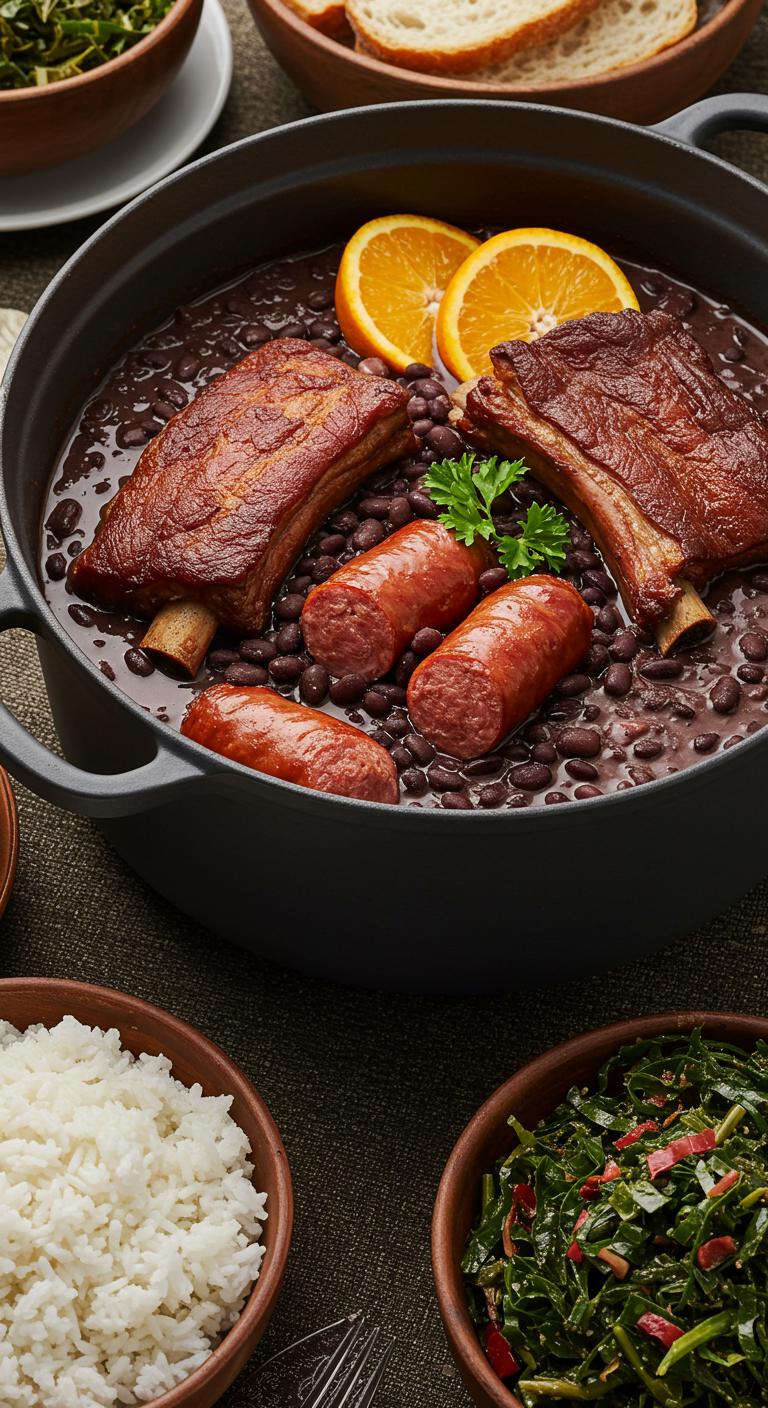
A rich, festive Brazilian black-bean stew loaded with smoky meats — comfort on a plate for holiday gatherings.
Ingredients:
- 500 g (1.1 lb) black beans, soaked overnight and drained
- 300 g (10 oz) pork shoulder, cut into 1–2 cm pieces
- 200 g (7 oz) smoked pork ribs or bacon, chopped
- 200 g (7 oz) linguiça or other smoked sausage, sliced
- 100 g (3.5 oz) pork trotters or smoked ham hock (optional)
- 1 large onion, finely chopped
- 4 garlic cloves, minced
- 2 bay leaves
- 1 orange (zest and juice)
- 2 tablespoons lard or vegetable oil
- Salt and freshly ground black pepper, to taste
- Water or low-sodium chicken broth, enough to cover beans by 2–3 cm
- Fresh chopped parsley or coriander, for garnish
- Orange wedges, for serving
- Cooked white rice, farofa, and collard greens (couve) to serve
How to Make:
- Sear the pork shoulder, ribs/bacon, and sausage in a large heavy pot with lard or oil over medium-high heat until browned. Remove and set aside.
- In the same pot, sauté the onion until soft, about 4 minutes, then add the garlic and cook 1 minute more.
- Return the meats to the pot with the drained beans. Add bay leaves and enough water or broth to cover by about 2–3 cm.
- Bring to a boil, then reduce heat to low, cover partially, and simmer gently for 1.5–2 hours, stirring occasionally, until beans are tender and meats are falling apart.
- If using a pressure cooker, cook for about 25–30 minutes on high after reaching pressure, then release and check tenderness.
- Mash a cup of the cooked beans against the side of the pot to thicken the stew, then stir well.
- Add orange zest and a splash of orange juice, season with salt and pepper to taste, and simmer 5–10 minutes more.
- Remove bay leaves and any large bone pieces; adjust seasoning.
- Serve hot over white rice with collard greens, farofa, orange wedges, and a sprinkle of chopped parsley or coriander.
Enjoy this hearty, smoky feijoada — perfect for sharing with friends and family around the holidays!
Kleftiko (Greek Slow-Roasted Lamb)
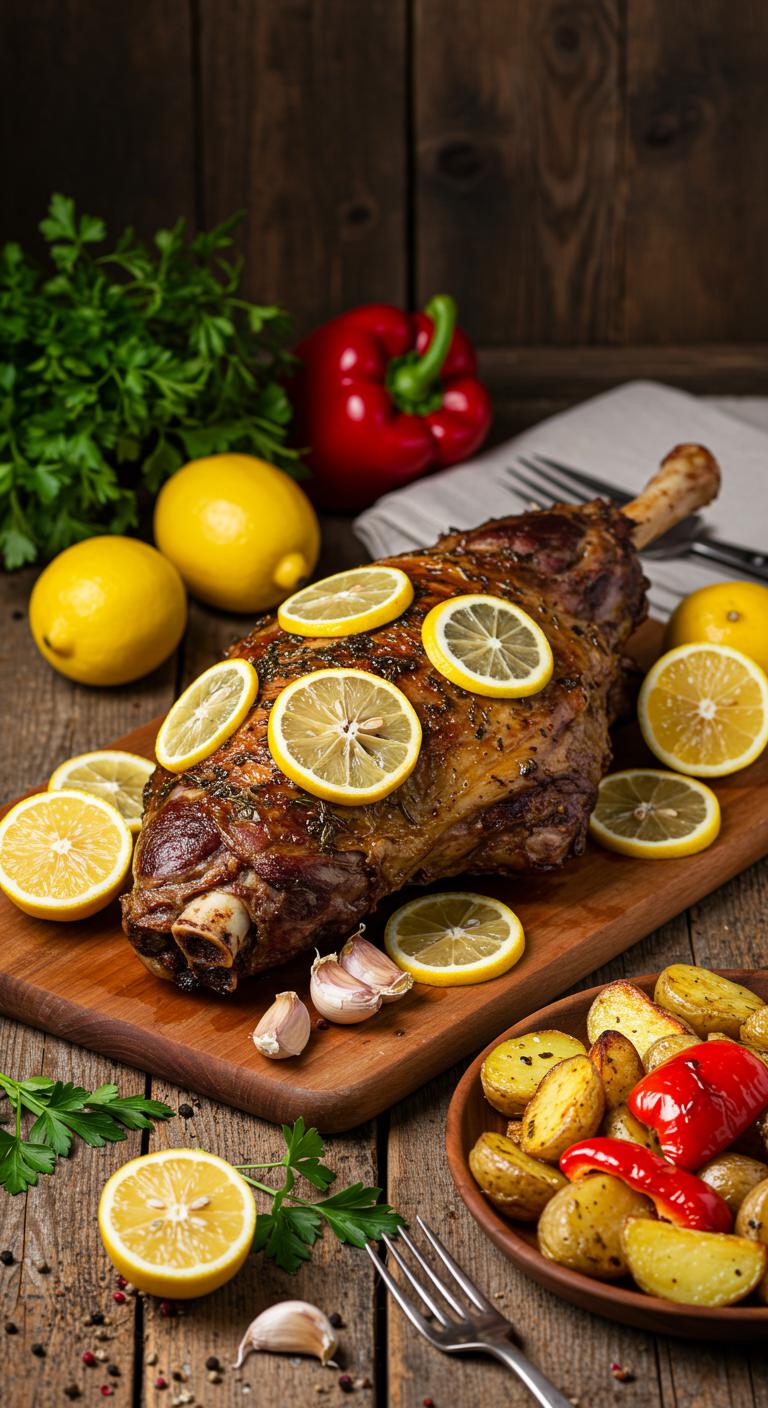
A rustic Greek classic: tender, slow-roasted lamb wrapped with lemon, garlic and herbs until meltingly soft.
Ingredients:
- 3–4 lb (1.4–1.8 kg) bone-in lamb shoulder or leg, cut into large chunks
- 4 garlic cloves, thinly sliced
- 1 large lemon, zest and juice
- 2 tbsp extra-virgin olive oil
- 1 tbsp dried oregano (or 2 tbsp fresh, chopped)
- 1 tsp dried thyme or rosemary, crushed
- 1 tsp ground cumin (optional)
- 1 tsp sea salt
- 1/2 tsp freshly ground black pepper
- 3–4 medium potatoes, peeled and cut into large chunks
- 1 large onion, thickly sliced
- 1 red bell pepper, cut into strips (optional)
- 1/2 cup dry white wine or water
- 2 bay leaves
- 1–2 sheets of parchment paper or large pieces of foil for wrapping
- Extra lemon slices and chopped fresh parsley for serving
How to Make:
- Pat the lamb pieces dry and place in a large bowl.
- Add garlic, lemon zest and juice, olive oil, oregano, thyme/rosemary, cumin (if using), salt and pepper; toss to coat. Marinate 30 minutes to 2 hours in the fridge if you have time.
- Preheat oven to 325°F (160°C).
- On a large sheet of parchment or foil, make a bed with the potato chunks, onion slices and bell pepper strips; scatter bay leaves among them.
- Pile the lamb on top of the vegetables, pour the wine or water around (not over) the lamb, and tuck extra lemon slices among the pieces.
- Fold the parchment/foil into a very tight parcel, sealing all edges so steam is trapped — double-wrap if using foil for a better seal.
- Place the parcel on a baking tray and roast for 3–4 hours, until the lamb is fall-apart tender and the potatoes are soft.
- Carefully open the parcel (watch for hot steam) and transfer to a serving platter; spoon any pan juices over the meat and vegetables.
- Sprinkle with chopped parsley and serve with extra lemon wedges.
Enjoy this slow-roasted, lemony Kleftiko — rustic comfort straight from the oven to your table.
Platschki and Kutia (Ukrainian Holiday Grains and Pancakes)
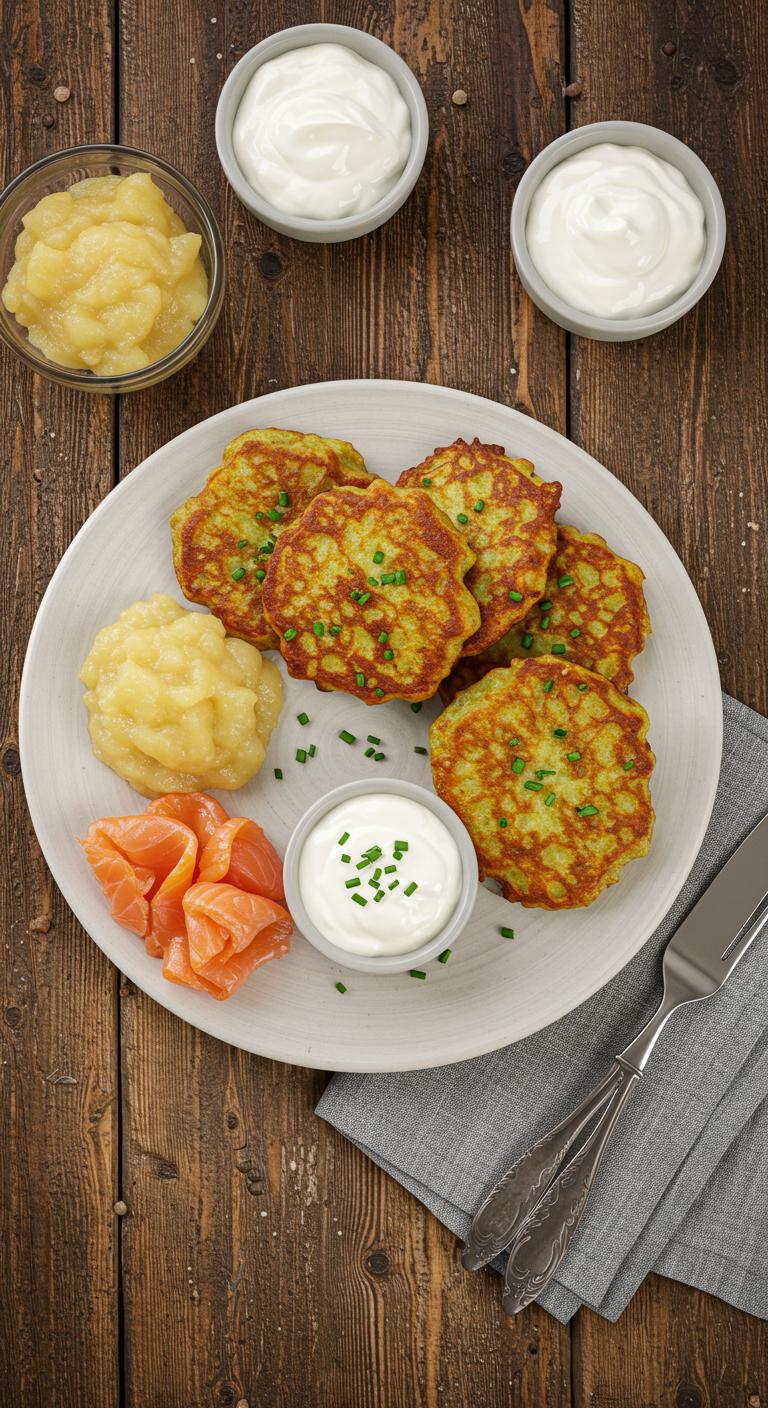
Platschki — Ukrainian potato pancakes: crispy golden rounds that are comforting, simple, and perfect with sour cream.
Ingredients:
- 2 pounds (about 900 g) potatoes, peeled
- 1 small onion
- 1 large egg
- 3 tablespoons all-purpose flour (plus extra if needed)
- 1 teaspoon salt, or to taste
- 1/4 teaspoon black pepper
- Vegetable oil for frying (about 1/2 cup)
- Optional for serving: sour cream, applesauce, chopped chives, or smoked salmon
How to Make:
- Grate the potatoes finely using a box grater or food processor and place them in a clean kitchen towel.
- Squeeze out as much liquid as possible from the grated potatoes into a bowl; let the starch settle for a minute, then pour off the watery part, leaving the starch.
- Finely grate the onion and add it to the drained potatoes.
- Stir in the reserved potato starch, egg, flour, salt, and pepper until the mixture holds together; add a little more flour if the batter is too wet.
- Heat a thin layer of vegetable oil in a large skillet over medium-high heat.
- Spoon heaping tablespoons of the potato mixture into the hot oil and flatten gently with the back of the spoon into rounds about 1/4–1/2 inch thick.
- Fry until the edges are golden and crisp, about 3–4 minutes per side, then flip and cook the other side until golden and cooked through.
- Transfer cooked platschki to a paper towel-lined plate to drain excess oil; keep warm in a low oven while you finish the rest.
- Serve hot with sour cream, applesauce, or your favorite toppings.
Enjoy these crispy platschki warm — simple, hearty, and utterly satisfying!
Jollof Rice With Fried Plantain (West African Festive Rice)
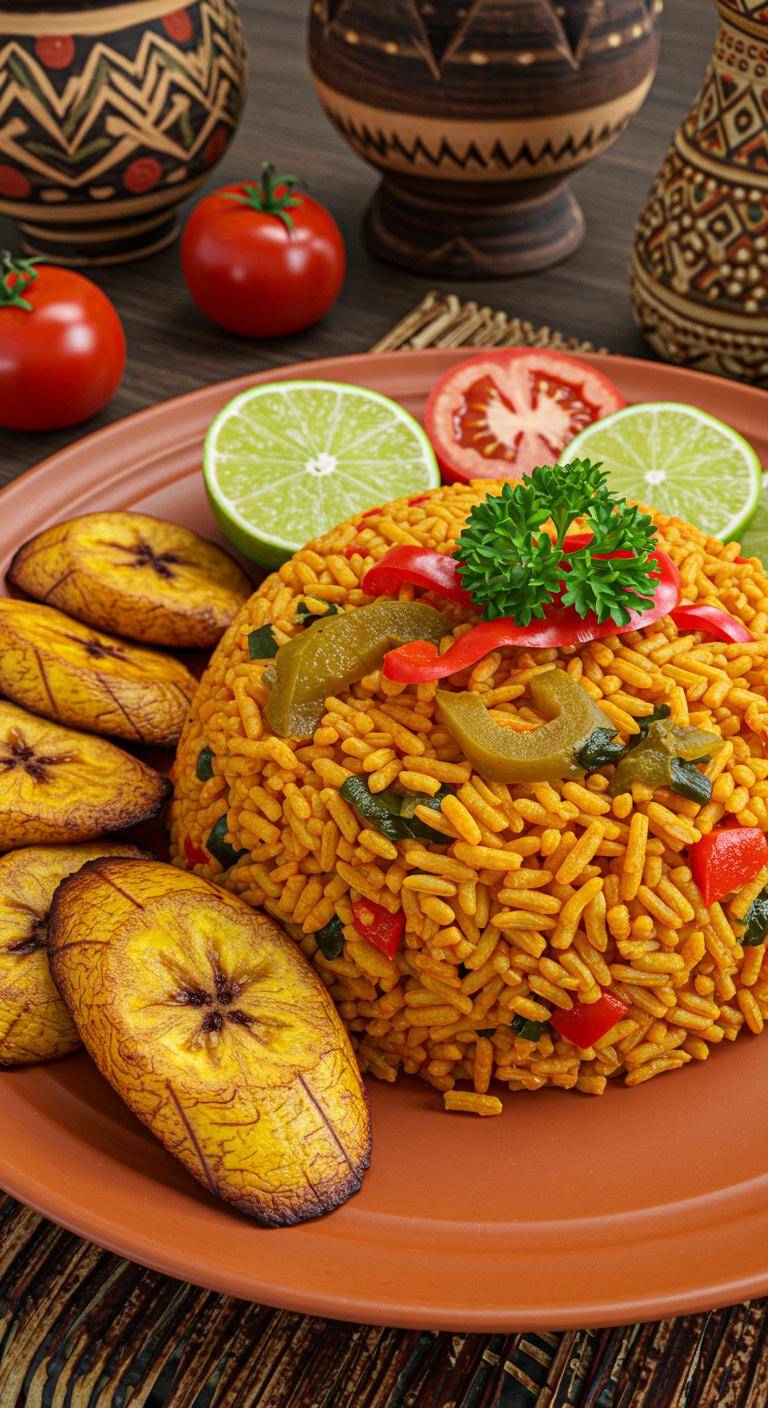
A vibrant, smoky West African rice dish served with sweet fried plantains — festive, comforting, and full of flavor.
Ingredients:
- 2 cups long-grain parboiled rice, rinsed
- 1/3 cup vegetable oil (plus extra for frying)
- 1 large onion, finely chopped (divide into half)
- 1 red bell pepper, seeded and roughly chopped
- 2 medium tomatoes (or 1 cup canned crushed tomatoes)
- 2 tbsp tomato paste
- 2-3 Scotch bonnet or habanero peppers (adjust to heat preference)
- 2-3 cloves garlic
- 1-inch piece fresh ginger (or 1 tsp ground ginger)
- 3 cups chicken or vegetable stock
- 1 tsp smoked paprika
- 1 tsp curry powder
- 1 tsp thyme (dried or 1 tsp fresh)
- 2 bay leaves
- Salt and freshly ground black pepper, to taste
- 1 lb chicken pieces or protein of choice (optional; cooked and seasoned)
- 2 ripe plantains, peeled and sliced diagonally into 1/2-inch pieces
- 1-2 tbsp sugar (optional, for plantains)
- Fresh parsley or cilantro, chopped, for garnish
- Lime wedges (optional)
How to Make:
- Blend red bell pepper, tomatoes, half the onion, Scotch bonnet peppers, garlic, and ginger into a smooth paste; set aside.
- Heat 1/3 cup oil in a large heavy pot over medium heat. Add the remaining chopped onion and sauté until soft and translucent.
- Stir in tomato paste and cook 2 minutes to deepen the flavor.
- Pour in the blended pepper-tomato mix and simmer for 8–10 minutes, stirring occasionally, until the sauce reduces and darkens.
- Season the sauce with smoked paprika, curry powder, thyme, bay leaves, salt and pepper. Taste and adjust heat/salt.
- Add the rinsed rice to the pot and stir to coat every grain in the sauce for 2 minutes.
- Pour in the stock, bring to a gentle boil, then reduce heat to low, cover tightly, and simmer 20–25 minutes until rice is tender and liquid is absorbed.
- If using cooked chicken or other protein, fold it into the rice in the last 5 minutes to warm through.
- While rice cooks, heat a few tablespoons of oil in a skillet over medium-high heat for the plantains.
- Toss plantain slices in a little salt and optional sugar, then fry in batches until golden brown and caramelized, about 2–3 minutes per side. Drain on paper towels.
- Fluff the Jollof rice with a fork, remove bay leaves, and adjust seasoning as needed.
- Serve rice topped or sided with fried plantains, garnish with chopped parsley or cilantro and lime wedges.
Enjoy the warm, smoky flavors and sweet crunch — a festive plate that brings West Africa straight to your table!
Christmas Eve Seafood Feast (Polish Wigilia/Italian La Vigilia Style)
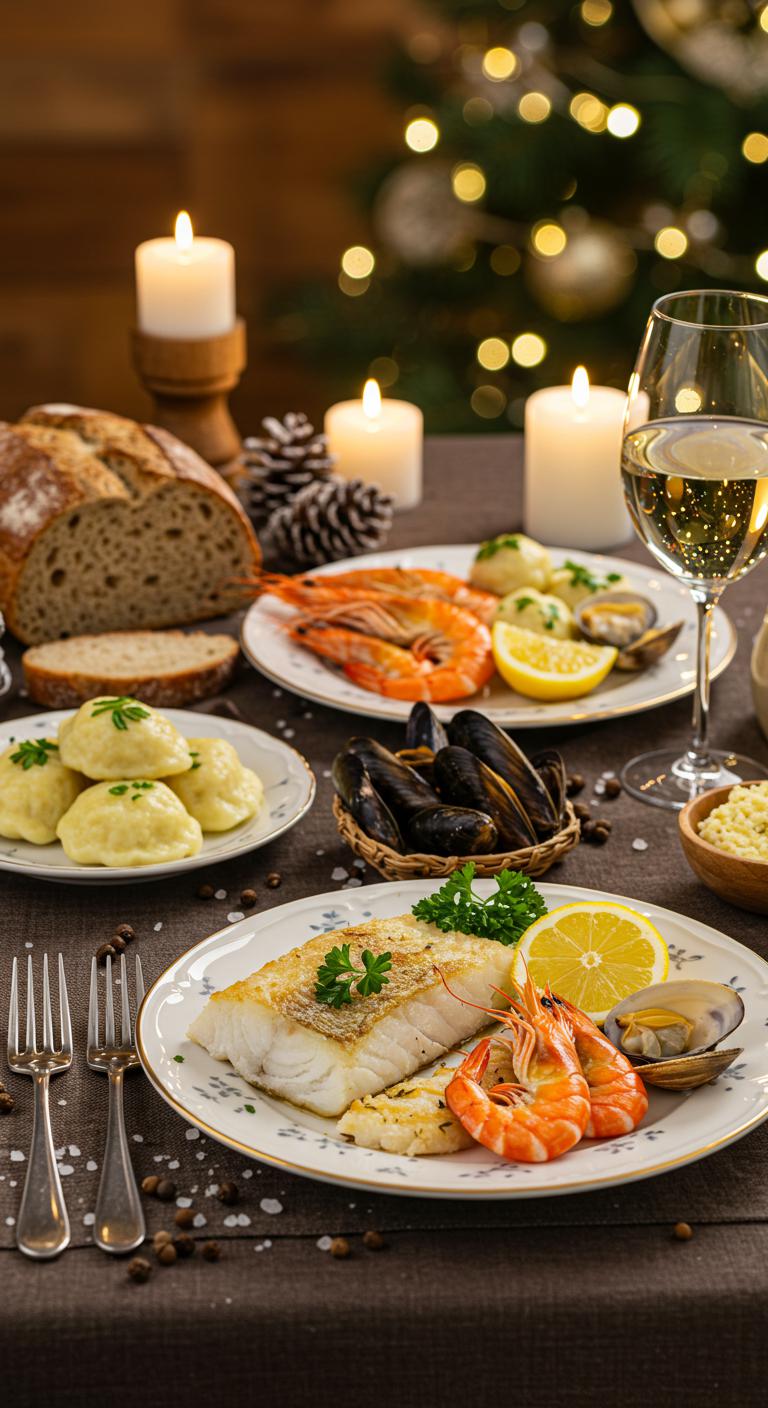
A celebratory spread of tender fish and shellfish inspired by Polish Wigilia and Italian La Vigilia traditions — light, lemony, and perfect for sharing.
Ingredients:
- 1 lb (450 g) cod fillets or other firm white fish, skin removed
- 12 large shrimp, peeled and deveined
- 12 mussels, scrubbed and debearded
- 12 clams, scrubbed
- 8 oz (225 g) smoked salmon, thinly sliced
- 1 cup all-purpose flour (for dredging)
- 1 tsp salt
- 1/2 tsp black pepper
- 1/2 cup olive oil
- 4 tbsp unsalted butter
- 4 cloves garlic, thinly sliced
- 1 small onion, thinly sliced
- 1 cup dry white wine
- 1 lemon, juiced + extra wedges to serve
- 1/4 cup fresh parsley, chopped
- 1 tsp red pepper flakes (optional)
- 2 bay leaves
- 1 cup fish or vegetable stock
- 1 lb (450 g) small potatoes, boiled and halved (optional side)
- Crusty bread or boiled dumplings/uszka (optional, for serving)
How to Make:
- Pat the cod dry and cut into large bite-sized pieces; season with salt and pepper and lightly dredge in flour.
- Heat 2 tbsp olive oil and 2 tbsp butter in a large skillet over medium-high heat.
- Sear the cod pieces 2–3 minutes per side until golden and just cooked through; remove to a plate and keep warm.
- In the same pan, add 1 tbsp olive oil and sauté the sliced onion until soft, about 4 minutes.
- Add the garlic and red pepper flakes (if using) and cook 30 seconds until fragrant.
- Pour in the white wine, add bay leaves, and simmer 2 minutes to reduce slightly.
- Add the mussels and clams, pour in the stock, cover, and steam 4–6 minutes until shells open; discard any that remain closed.
- Remove shellfish to a bowl, reserving the cooking liquid in the pan.
- Melt the remaining 2 tbsp butter and 1 tbsp olive oil in the pan, add the shrimp, and cook 1–2 minutes per side until pink; squeeze in half the lemon juice.
- Gently return the seared cod and the smoked salmon slices to the pan to warm through for 1–2 minutes.
- Add the cooked mussels, clams, and any juices back into the skillet; toss gently to combine and heat evenly.
- Taste and adjust seasoning with salt, pepper, and remaining lemon juice. Stir in chopped parsley.
- Serve the seafood and broth over boiled halved potatoes or with crusty bread or uszka to soak up the juices.
- Garnish with extra parsley and lemon wedges, and enjoy this festive, sea-kissed feast!
Buon appetito — and Smacznego!
Sugar Cookies and Pfeffernüsse (Scandinavian and German Holiday Cookies)

Ingredients:
- 2 3/4 cups (345 g) all-purpose flour
- 1 teaspoon baking soda
- 1/2 teaspoon baking powder
- 1 cup (226 g) unsalted butter, softened
- 1 1/2 cups (300 g) granulated sugar
- 1 large egg
- 1 teaspoon vanilla extract
- 1/2 teaspoon almond extract (optional)
- 3 to 4 tablespoons milk, as needed
- Sprinkles or sanding sugar for decorating
How to Make:
- Preheat the oven to 350°F (175°C). Line baking sheets with parchment.
- Whisk flour, baking soda, and baking powder in a bowl; set aside.
- Beat the softened butter and sugar together until light and fluffy, about 2–3 minutes.
- Add the egg, vanilla, and almond extract; mix until combined.
- Gradually add the dry ingredients and mix until the dough comes together. Add milk 1 tablespoon at a time if dough seems too stiff.
- Divide the dough in half, flatten into disks, wrap in plastic, and chill in the fridge for at least 1 hour.
- Roll dough on a lightly floured surface to about 1/4-inch thickness and cut into shapes with cookie cutters.
- Place cookies on prepared baking sheets about 1 inch apart. Decorate with sprinkles or sanding sugar if desired.
- Bake for 8–10 minutes, or until edges are just starting to turn golden. Let cool on the sheet for 2 minutes, then transfer to a wire rack to cool completely.
- Once cool, add any additional icing or decorations you like.
Enjoy these sweet, buttery cutouts — perfect for decorating with family and sharing around the tree!
Pfeffernüsse — Spiced German Holiday Cookies
Ingredients:
- 2 1/4 cups (280 g) all-purpose flour
- 1/2 cup (100 g) granulated sugar
- 1/2 cup (110 g) brown sugar, packed
- 1 teaspoon baking powder
- 1/2 teaspoon baking soda
- 2 teaspoons ground cinnamon
- 1 1/2 teaspoons ground cloves
- 1 1/2 teaspoons ground nutmeg
- 1 teaspoon ground allspice
- 1/2 teaspoon ground black pepper (or 1 teaspoon for more zing)
- 1/2 teaspoon salt
- 1/2 cup (115 g) unsalted butter, softened
- 1/2 cup (160 g) dark molasses
- 1 large egg
- 1 teaspoon vanilla extract
- 1/4 cup (60 ml) strong brewed coffee or warm milk (optional, to adjust dough)
- Confectioners’ sugar for dusting or icing
How to Make:
- In a bowl, whisk together flour, baking powder, baking soda, spices, and salt.
- In a separate large bowl, cream the softened butter with granulated and brown sugars until smooth.
- Beat in the molasses, egg, and vanilla until well combined.
- Gradually add the dry ingredients to the wet mixture, mixing to form a soft dough. Add a bit of coffee or warm milk if the dough feels too stiff.
- Cover the dough and chill in the refrigerator for at least 1 hour to firm up and let flavors meld.
- Preheat oven to 350°F (175°C) and line baking sheets with parchment.
- Roll tablespoons of dough into small balls (about 1 inch) and place them about 2 inches apart on the prepared sheets.
- Bake for 10–12 minutes; cookies will puff slightly and set. Allow to cool on the sheet for a few minutes before transferring to a wire rack.
- When completely cool, toss the cookies lightly in confectioners’ sugar or brush with a simple glaze and dust with sugar for a shiny finish.
These little spice bombs are cozy, fragrant, and perfect with a cup of mulled wine or hot cocoa — enjoy the warm holiday flavors!
Coquito and Rellenos De Papa (Puerto Rican Coquito and Stuffed Potatoes)
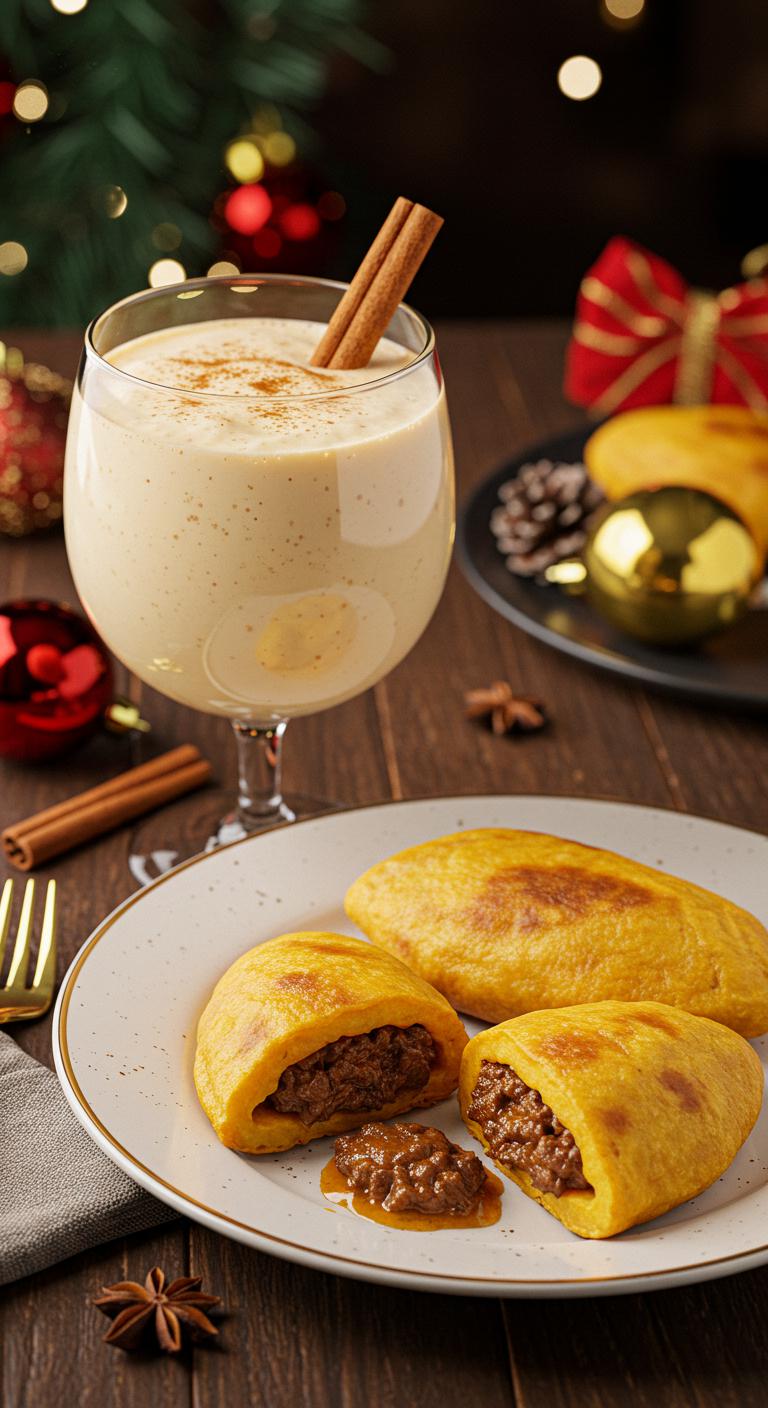
Coquito and Rellenos de Papa — a creamy coconut Christmas sipper paired with savory Puerto Rican stuffed potatoes.
Ingredients:
- For the Coquito:
- 1 can (12 oz) evaporated milk
- 1 can (14 oz) sweetened condensed milk
- 1 can (13.5 oz) coconut milk
- 1 can (15 oz) cream of coconut (e.g., Coco López)
- 1–1½ cups white rum (adjust to taste)
- 1 tsp vanilla extract
- 1 tsp ground cinnamon
- ¼ tsp ground nutmeg
- Cinnamon sticks and ground cinnamon for garnish
- Ice for serving
- For the Rellenos de Papa (Stuffed Potatoes):
- 2 lb russet potatoes (about 4 large)
- 1 lb ground beef
- 1 small onion, finely chopped
- 1 small green bell pepper, finely chopped
- 2 cloves garlic, minced
- 2 tbsp sofrito (or substitute: 1 tbsp tomato paste + 1 tbsp finely chopped cilantro)
- 1/2 cup tomato sauce
- 1/4 cup green olives, chopped (optional)
- 1/4 cup raisins (optional)
- 1 tsp dried oregano
- 1/2 tsp ground cumin
- Salt and pepper to taste
- 2 large eggs, beaten (for binding the mashed potato)
- 1/2 cup all-purpose flour (for coating)
- 1 cup breadcrumbs
- Oil for frying (vegetable or canola)
How to Make:
- Make the coquito: In a blender, combine evaporated milk, sweetened condensed milk, coconut milk, cream of coconut, rum, vanilla, cinnamon, and nutmeg. Blend until smooth.
- Taste and adjust rum or spices as desired.
- Chill the coquito in the fridge for at least 2 hours (overnight is best).
- Serve coquito cold over ice, garnish with a sprinkle of cinnamon and a cinnamon stick.
- Prepare potatoes: Peel and cut potatoes into chunks. Boil in salted water until very tender, about 15–20 minutes.
- Drain potatoes and mash until smooth. Let cool slightly.
- Stir beaten eggs and a pinch of salt into the mashed potatoes to make them pliable for shaping.
- Make the filling: In a skillet over medium heat, sauté onion, green pepper, and garlic until softened.
- Add ground beef and cook until browned, breaking it up as it cooks.
- Stir in sofrito, tomato sauce, olives, raisins (if using), oregano, cumin, salt, and pepper. Simmer 5–8 minutes until flavors meld. Remove from heat and let cool slightly.
- Shape the rellenos: Take a handful of mashed potato, flatten into a disc in your palm, add a spoonful of beef filling in the center, and fold the potato around the filling to form a ball or oval. Repeat with remaining potato and filling.
- Coat each relleno: Dredge in flour, dip in beaten egg, then roll in breadcrumbs to coat well.
- Fry rellenos: Heat oil in a deep skillet to about 350°F (175°C). Fry potatoes in batches until golden brown and crisp, about 3–4 minutes per side. Transfer to paper towels to drain.
- Serve hot with a side of Spanish-style pickled onions or a simple salad.
Enjoy a sip of creamy coquito with every savory bite of crispy rellenos de papa — the perfect Puerto Rican holiday duo!
Conclusion
You’ve sampled twelve festive dishes from around the world that you can make and share. Pick one recipe, gather ingredients, and follow the steps steadily. Roast, bake, steam, or fry with attention to timing and temperature. Plate with simple garnishes, serve warm when needed, and store leftovers properly. Want to set the table to match the dish and make the meal feel complete? Try one new recipe each year to build fresh holiday traditions.
